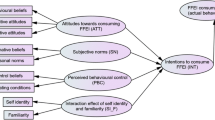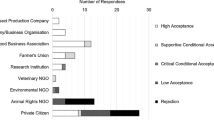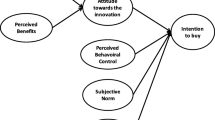Abstract
Limited access to good quality, adequate and affordable livestock feed impose a major challenge to livestock production in developing countries. In order to improve access to good quality and adequate livestock feed, policymakers, practitioners, and researchers are promoting the utilization of alternative feed sources. While insects have been promoted as an alternative source of protein, their production and utilization is low across smallholder livestock systems in sub-Saharan Africa. This study assessed smallholder farmers’ intention to use insect-based feed to supplement dairy cattle diets in Murang’a County in Kenya. The study employed the Theory of Planned Behaviour (TPB) and collected data from a random sample of 378 dairy farming households. A heteroscedastic probit (hetprobit) regression model was used to assess determinants of smallholder dairy farmers’ intention to use insect-based feed. Findings show that while only a small proportion of dairy farmers (11%) were aware of the use of insects as an alternative source of livestock feed, a considerable proportion (76%) were willing to use insect-based feed when they become available. The results of the hetprobit model revealed that the three TPB constructs; attitude, subjective norm and perceived behavioural control positively and significantly determined the likelihood of farmers’ intentions to use insect-based feed. Of the three constructs, attitude had the highest influence on the farmers’ intention to utilise insect-based feed, followed by perceived behavioural control and subjective norms. While age of the farmer, flock size, access to extension services and wealth status were positively associated with farmers’ intention to use insect-based feed, gender (being a male-headed household) of the farmer and farming experience had a negative influence on the likelihood of farmers’ intention. The study discusses the implications of these findings in scaling up the production and utilization of sustainable alternative protein feed sources.



Similar content being viewed by others
Notes
The other items in the scale were; (2) unlikely (3) neutral (4) likely.
Daxini et al. (2018) measured farmers’ intention to adopt nutrient management planning on an ordered five-point likert scale but found insufficient responses in the first three categories and therefore grouped these categories into two- either ‘(0) do not intend’ or ‘(1) intend’. While Verbeke et al. (2015) measured participants’ willingness to accept the use of insects in animal feed on a five-point likert scale but found that their two lowest response categories of the outcome variable had few observations and therefore merged these categories- therefore generating only four response categories.
References
Ajzen I (1991) The theory of planned behavior. Organ Behav Hum Decis Process 50:179–211
Alvarez RM, Brehm J (1995) American Ambivalence Towards Abortion Policy : Development of a Heteroskedastic Probit Model of Competing Values 39(4):1055–1082. http://www.jstor.org/stable/2111669
Ankamah-Yeboah I, Jacobsen JB, Olsen SB (2018) Innovating out of the fishmeal trap: The role of insect-based fish feed in consumers’ preferences for fish attributes. Br Food J. https://doi.org/10.1108/BFJ-11-2017-0604
Arunrat N, Wang C, Pumijumnong N, Sereenonchai S, Cai W (2017) Farmers’ intention and decision to adapt to climate change: A case study in the Yom and Nan basins, Phichit province of Thailand. J Clean Prod 143:672–685. https://doi.org/10.1016/j.jclepro.2016.12.058
Ateka JM, Mbeche RM, Muendo KM (2021) Determinants of protected tomato production technologies among smallholder peri-urban producers in kiambu county, Kenya. J Agric Rural Dev Trop Subtrop 122(1):43–52. https://doi.org/10.17170/kobra-202102113203
Aziz NABA, Aziz NNBA, Aris YBW, Aziz NABA (2015) Factors Influencing the Paddy Farmers’ Intention to Participate in Agriculture Takaful. Procedia Econ Financ 31(15):237–242. https://doi.org/10.1016/s2212-5671(15)01225-3
Balehegn M, Duncan A, Tolera A, Ayantunde AA, Issa S, Karimou M, Zampaligré N, André K, Gnanda I, Varijakshapanicker P, Kebreab E, Dubeux J, Boote K, Minta M, Feyissa F, Adesogan AT (2020) Improving adoption of technologies and interventions for increasing supply of quality livestock feed in low- and middle-income countries. Glob Food Sec 26:1–11. https://doi.org/10.1016/j.gfs.2020.100372
Bazoche P, Poret S (2021) Acceptability of insects in animal feed: A survey of French consumers. J Consum Behav 20(2):251–270. https://doi.org/10.1002/cb.1845
Borges JAR, Oude Lansink AGJM, Marques Ribeiro C, Lutke V (2014) Understanding farmers’ intention to adopt improved natural grassland using the theory of planned behavior. Livest Sci 169:163–174. https://doi.org/10.1016/j.livsci.2014.09.014
Burton RJF (2004) Reconceptualising the “behavioural approach” in agricultural studies: A socio-psychological perspective. J Rural Stud 20:359–371. https://doi.org/10.1016/j.jrurstud.2003.12.001
Buyinza J, Nuberg IK, Muthuri CW, Denton MD (2020) Psychological factors influencing farmers ’ intention to adopt agroforestry : a structural equation modeling approach psychological factors in fluencing farmers ’ intention to adopt agroforestry : a structural equation modeling approach. J Sustain for 00(00):1–12. https://doi.org/10.1080/10549811.2020.1738948
Chang HP, Ma CC, Chen HS (2019) Climate change and consumer’s attitude toward insect food. Int J Environ Res Public Health 16(9):1–17. https://doi.org/10.3390/ijerph16091606
Chia SY, Macharia J, Diiro GM, Kassie M, Ekesi S, van Loon JJA, Dicke M, Tanga CM (2020) Smallholder farmers’ knowledge and willingness to pay for insect-based feeds in Kenya. PLoS ONE 15(3):1–25. https://doi.org/10.1371/journal.pone.0230552
Cochran WG (1997) Sampling Techniques, 3rd edn. John Wiley & Sons, New York
Coleman BE (2006) Microfinance in Northeast Thailand: Who benefits and how much? World Dev 34(9):1612–1638. https://doi.org/10.1016/j.worlddev.2006.01.006
Daxini A, O’Donoghue C, Ryan M, Buckley C, Barnes AP, Daly K (2018) Which factors influence farmers’ intentions to adopt nutrient management planning? J Environ Manage 224:350–360. https://doi.org/10.1016/j.jenvman.2018.07.059
Dhraief MZ, Bedhiaf-Romdhania S, Dhehibib B, Oueslati-Zlaouia M, Jebali O, Youssef SB (2018) Factors affecting the adoption of innovative technologies by livestock farmers in arid area of Tunisia. Forum Agric Res Africa 3(5):1–22
Diaz SE, Speelman S, Moruzzo R, De Steur H (2021) Determinants of small-scale farmers’ intention to adopt insect farming for animal feed in Colombia. J Insects Food Feed. https://doi.org/10.3920/JIFF2020.0134
Dicke M (2018) Insects as feed and the Sustainable Development Goals. J Insects Food Feed 4(3):147–156. https://doi.org/10.3920/JIFF2018.0003
Domingues CHDF, Borges JAR, Ruviaro CF, Guidolin DGF, Carrijo JRM (2020) Understanding the factors influencing consumer willingness to accept the use of insects to feed poultry, cattle, pigs and fish in Brazil. PLoS ONE 15(4):1–11. https://doi.org/10.1371/journal.pone.0224059
Hjelm L, Mathiassen A, Miller D, Wadhwa A (2017) World Food Program, Creation of a Wealth Index; VAM-Guidance paper, p. 1–26
Khan SH (2018) Recent advances in role of insects as alternative protein source in poultry nutrition. J Appl Anim Res 46(1):1144–1157. https://doi.org/10.1080/09712119.2018.1474743
Lukuyu B, Franzel S, Ongadi PM, Duncan AJ (2011) Livestock feed resources: Current production and management practices in central and northern rift valley provinces of Kenya. Livest Res Rural Dev 23(112)
Malesse B (2018) A review on factors affecting adoption of agricultural new technologies in Ethiopia. J Agric Sci Food Res 9(3):1–4
Mancuso T, Baldi L, Gasco L (2016) An empirical study on consumer acceptance of farmed fish fed on insect meals: the Italian case. Aquacult Int 24(5):1489–1507. https://doi.org/10.1007/s10499-016-0007-z
Martínez-García CG, Arriaga-Jordán CM, Dorward P, Rehman T, Rayas-Amor AA (2016) Using a socio-psychological model to identify and understand factors influencing the use and adoption of a successful innovation by small-scale dairy farmers of central Mexico. Exp Agric. https://doi.org/10.1017/S0014479716000703
Micha E, Areal FJ, Tranter RB, Bailey AP (2015) Uptake of agri-environmental schemes in the Less-Favoured Areas of Greece: The role of corruption and farmers’ responses to the financial crisis. Land Use Policy 48:144–157. https://doi.org/10.1016/j.landusepol.2015.05.016
Moussa RK (2019) Heteroskedasticity in one-way error component probit models. Econometrics 7(3):1–22. https://doi.org/10.3390/econometrics7030035
Mutisya MM, Agbodzavu MK, Kinyuru JN, Tanga CM, Gicheha M, Hailu G, Salifu D, Khan Z, Niassy S (2021) Can black soldier fly Desmodium intortum larvae-based diets enhance the performance of Cobb500 broiler chickens and smallholder farmers’ profit in Kenya? Poult Sci 100:420–430. https://doi.org/10.1016/j.psj.2020.11.021
Ogada M, Wilfred N, And Mahmud Y (2010) Production risk and farm technology adoption in the rain-fed semi-arid lands of Kenya. African J Agric Resour Econ 4(2):159–174
Okello AO, Nzuma JM, Otieno DJ, Kidoido M, Tanga CM (2021) Farmers’ perceptions of commercial insect-based feed for sustainable livestock production in Kenya. Sustainability 13(5359):1–13. https://doi.org/10.3390/su13105359
Omollo EO, Wasonga OV, Elhadi MY, Mnene WN (2018) Determinants of pastoral and agro-pastoral households ’ participation in fodder production in Makueni and Kajiado Counties , Kenya. Pastoralism Res Policy Pract 8(9):1–10. https://doi.org/10.1186/s13570-018-0113-9
Onsongo VO, Osuga IM, Gachuiri CK, Wachira AM, Miano DM, Tanga CM, Ekesi S, Nakimbugwe D, Fiaboe KKM (2018) Insects for income generation through animal feed: Effect of dietary replacement of soybean and fish meal with black soldier fly meal on broiler growth and economic performance. J Econ Entomol 20(10):1–8. https://doi.org/10.1093/jee/toy118
Orwa S, Oyoo R (2020) Measuring the Rural Transport Premium in Murang ’ a County. Final Report, Kenya
Pambo KO, Mbeche RM, Okello JJ, Mose GN, Kinyuru JN (2018) Intentions to consume foods from edible insects and the prospects for transforming the ubiquitous biomass into food. J Agric Food Human Values Soc 35(4):885–898. https://doi.org/10.1007/s10460-018-9881-5
Paul BK, Koge J, Maass BL, Notenbaert A, Peters M, Groot JCJ, Tittonell P (2020) Tropical forage technologies can deliver multiple benefits in Sub-Saharan Africa. A Meta-analysis. Agron Sustain Dev 40(22):1–17. https://doi.org/10.1007/s13593-020-00626-3
Pomalégni SCB, Kpadé CP, Gbemavo DSJC, Clottey VA, Kenis M, Mensah GA (2018) Traditional poultry farmers’ willingness to pay for using fly larvae meal as protein source to feed local chickens in Benin. Bio-Based Appl Econ 7(2):117–138. https://doi.org/10.13128/bae-7671
Rademaker C, Bebe BO, Van Der Lee J, Kilelu C, Tonui C (2016) Sustainable growth of the Kenyan dairy sector; A quick scan of robustness, reliability and resilience. Report 3R Kenya/WLR 979. https://doi.org/10.18174/391018
Republic of Kenya (2019) Kenya population and housing census volume 1: Population by County and sub-County. In Kenya National Bureau of Statistics: Vol. I. https://www.knbs.or.ke/?wpdmpro=2019-kenya-population-and-housing-census-volume-i-population-by-county-and-sub-county
Rezaei R, Seidi M, Karbasioun M (2019) Pesticide exposure reduction: Extending the theory of planned behavior to understand Iranian farmers’ intention to apply personal protective equipment. Saf Sci 120:527–537. https://doi.org/10.1016/j.ssci.2019.07.044
Ritter C, Jansen J, Roche S, Kelton DF, Adams CL, Orsel K, Erskine RJ, Benedictus G, Lam TJGM, Barkema HW (2017) Invited review: Determinants of farmers’ adoption of management-based strategies for infectious disease prevention and control. J Dairy Sci 100(5):3329–3347. https://doi.org/10.3168/jds.2016-11977
Sebatta C, Ssepuuya G, Sikahwa E, Mugisha J, Diiro G, Sengendo M, Fuuna P, Fiaboe K, Nakimbugwe D (2018) Farmers’ acceptance of insects as an alternative protein source in poultry feeds. Int J Agric Res Innov Technol 8(2):32–41. https://doi.org/10.3329/ijarit.v8i2.40553
Senger I, Borges JAR, Machado JAD (2017) Using the theory of planned behavior to understand the intention of small farmers in diversifying their agricultural production. J Rural Stud 49:32–40. https://doi.org/10.1016/j.jrurstud.2016.10.006
Sogari G, Amato M, Biasato I, Chiesa S, Gasco L (2019) The potential role of insects as feed: A multi-perspective review. Animals 9(4):1–15. https://doi.org/10.3390/ani9040119
Ssepuuya G, Namulawa V, Mbabazi D, Mugerwa S, Fuuna P, Nampijja Z, Ekesi S, Fiaboe KKM, Nakimbugwe D (2017) Use of insects for fish and poultry compound feed in sub-Saharan Africa - A systematic review. J Insects Food Feed 3(4):289–302. https://doi.org/10.3920/JIFF2017.0007
Szendro K, Nagy MZ, Toth K (2020) Consumer acceptance of meat from animals reared on insect meal as feed. Animals 10:1–10. https://doi.org/10.3390/ani10081312
Tadesse T (2021) Review on feed resources with more emphasis on use of cassava and sweet potato meal in chicken diet : Ethiopia. Anim Vet Sci 9(2):32–38. https://doi.org/10.11648/j.avs.20210902.11
Tegemeo Institute of Agricultural Policy and Development (2021) Report on a study on cost of milk production in Kenya. https://www.kdb.go.ke/wp-content/uploads/2021/06/Cost-of-milk-production-report..pdf
Udimal TB, Jincai Z, Mensah OS, Caesar AE (2017) Factors influencing the agricultural technology adoption : The case of improved rice varieties ( Nerica ) in the Northern Region, Ghana. J Econ Sustain Dev 8(8):137–148
Ursachi G, Horodnic IA, Zait A (2015) How reliable are measurement scales ? External factors with indirect influence on reliability estimators. Procedia Econom Financ 20:679–686. https://doi.org/10.1016/S2212-5671(15)00123-9
van Huis A (2022) Edible insects: Challenges and prospects. Entomol Res 52:161–177. https://doi.org/10.1111/1748-5967.12582
van Huis A, van Itterbeeck J, Klunder H, Mertens E, Halloran A, Muir G, Vantomme P (2013) Edible insects. Future prospects for food and feed security. In Food and Agriculture Organization of the United Nations (Vol. 171)
Vartiainen O, Elorinne AL, Niva M, Väisänen P (2020) Finnish consumers’ intentions to consume insect-based foods. J Insects Food Feed 6(3):261–272. https://doi.org/10.3920/jiff2019.0042
Verbeke W, Spranghers T, De Clercq P, De Smet S, Sas B, Eeckhout M (2015) Insects in animal feed: Acceptance and its determinants among farmers, agriculture sector stakeholders and citizens. Anim Feed Sci Technol 204:72–87. https://doi.org/10.1016/j.anifeedsci.2015.04.001
Vernooij AG, Veldkamp T (2018) Insects for Africa; Developing business opportunities for insects in animal feed in Eastern Africa. Wageningen Livestock Research, Report 1150. https://doi.org/10.18174/470617
Waithanji E, Affognon DH, King’ori S, Diiro G, Nakimbugwe D, Fiaboe KKM (2020) Insects as feed: Gendered knowledge attitudes and practices among poultry and Pond Fish farmers in Kenya. NJAS Wagen J Life Sci 92:1–15. https://doi.org/10.1016/j.njas.2019.100312
Funding
The funding for this research was provided by the National Research Fund (NRF), Kenya.
Author information
Authors and Affiliations
Contributions
Diana Wanda: Conceptualization, visualization, methodology, formal analysis, investigation, writing- original draft preparation, and writing- review and editing. Josiah Ateka: Visualization, validation, resources, writing- review and editing, supervision, project and administration. Robert Mbeche: Visualization, validation, resources, writing- review and editing, supervision, and project administration. Mathew Gicheha: Visualization, validation, resources, writing- review and editing, supervision, project administration, and funding acquisition.
Corresponding author
Ethics declarations
Conflict of interest
The authors declare that they have no conflict of interest.
Additional information
Publisher's Note
Springer Nature remains neutral with regard to jurisdictional claims in published maps and institutional affiliations.
Annex
Annex
Annex 1 Description and measurement of variables used in the study
Variables | Description and measurement |
|---|---|
Dependent variable | |
Intention | Farmers’ willingness to use insect-based feeds measured on a five-point likert scale (1) very unlikely, (2) unlikely, (3) neutral, (4) likely, (5) very likely |
Independent variables | |
Age | Age of the household head in years |
Gender | Sex of the household head (1 if male, 0 otherwise) |
Education level | The highest level of education attained by the household head (1 if had post-primary education, 0 if had primary education and below) |
Farming experience | Experience of household head in dairy farming in years |
Household size | Total number of members in a household |
Farm size | Total amount of land owned by the farm household in acres |
Dairy cattle | Total number of dairy cattle kept by the household during the time of the survey |
Milk yield | Milk yield of lactating dairy cows kept by the household in litres per cow per day |
Distance to market | Distance from the farm to the nearest market in kilometres |
Household income | Annual income from all income sources in the household in Kenya shillings (KES) in the last year preceding the survey |
Access to extension service | Household access to extension service within the last year preceding the survey (1 if had access, 0 otherwise) |
Access to credit | Household access to credit during the last year preceding the survey (1 if had access, 0 otherwise) |
Access to insurance service | Household access to insurance service (1 if had access, 0 otherwise) |
Group membership | Membership to a farmer group or association (1 if belongs to a farmer group or association, 0 otherwise) |
Household wealth category | Measure of a household’s cumulative living standarda (Poorest, Middle, Wealthiest) |
Awareness | Farmer awareness of insects as source of livestock feed (1 if yes, 0 otherwise) |
Annex 2 Coefficient estimates of determinants of farmers’ intention to use insect-based feed
Variable | Probit model | Hetprobit model | ||||
|---|---|---|---|---|---|---|
Coef | S.E | p-value | Coef | S.E | p-value | |
Awareness of insect-based feed | -0.128 | 0.280 | 0.647 | -0.140 | 0.207 | 0.499 |
TPB Constructs | ||||||
Attitude | 0.483*** | 0.107 | 0.000 | 0.532*** | 0.116 | 0.000 |
Subjective norms | 0.420*** | 0.107 | 0.000 | 0.359*** | 0.090 | 0.000 |
Perceived behavioural control | 0.497*** | 0.190 | 0.009 | 0.391*** | 0.148 | 0.008 |
Household characteristics | ||||||
Gender of household head | -0.132 | 0.258 | 0.609 | -0.512** | 0.247 | 0.038 |
Age of household head | 0.006 | 0.008 | 0.430 | 0.012* | 0.007 | 0.099 |
Farming experience | -0.009 | 0.008 | 0.310 | -0.014* | 0.008 | 0.067 |
Education of household head | 0.242 | 0.190 | 0.202 | 0.130 | 0.147 | 0.374 |
Household size | -0.030 | 0.053 | 0.565 | -0.046 | 0.043 | 0.285 |
Farm size | -0.085** | 0.043 | 0.050 | -0.024 | 0.022 | 0.276 |
Number of dairy cattle | 0.063 | 0.063 | 0.320 | 0.110* | 0.060 | 0.065 |
Distance from the farm to the nearest market | -0.032 | 0.042 | 0.448 | -0.046 | 0.038 | 0.230 |
Household income | -0.012 | 0.121 | 0.924 | -0.070 | 0.095 | 0.462 |
Wealth index (Wealthiest) | 0.396 | 0.295 | 0.180 | 0.507** | 0.239 | 0.034 |
Wealth index (Middle) | 0.130 | 0.208 | 0.533 | 0.581** | 0.282 | 0.039 |
Institutional arrangements | ||||||
Access to credit | 0.117 | 0.219 | 0.594 | -0.652*** | 0.175 | 0.000 |
Access to extension service | 0.416* | 0.218 | 0.057 | 0.414** | 0.180 | 0.022 |
Access to insurance service | 0.070 | 0.205 | 0.733 | 0.223 | 0.146 | 0.127 |
Log-likelihood | -129.14 | -120.07 | ||||
Pseudo-R2 | 0.34 | |||||
LR | 132.03*** | |||||
Homoskedasticity (LM Test) | 26.05* | |||||
Wald test (χ2 with 18 df) | 67.61*** | |||||
Het-test (χ2 with 2 df) | 18.14*** | |||||
Rights and permissions
Springer Nature or its licensor holds exclusive rights to this article under a publishing agreement with the author(s) or other rightsholder(s); author self-archiving of the accepted manuscript version of this article is solely governed by the terms of such publishing agreement and applicable law.
About this article
Cite this article
Odinya, D.W., Ateka, J.M., Mbeche, R.M. et al. Smallholder farmers’ intention to use insect-based feed in dairy cattle diet in Kenya. Int J Trop Insect Sci 42, 3695–3711 (2022). https://doi.org/10.1007/s42690-022-00891-7
Received:
Accepted:
Published:
Issue Date:
DOI: https://doi.org/10.1007/s42690-022-00891-7




